Public Health - Obesity | Assignment
VerifiedAdded on 2022/08/26
|13
|4052
|49
AI Summary
Contribute Materials
Your contribution can guide someone’s learning journey. Share your
documents today.
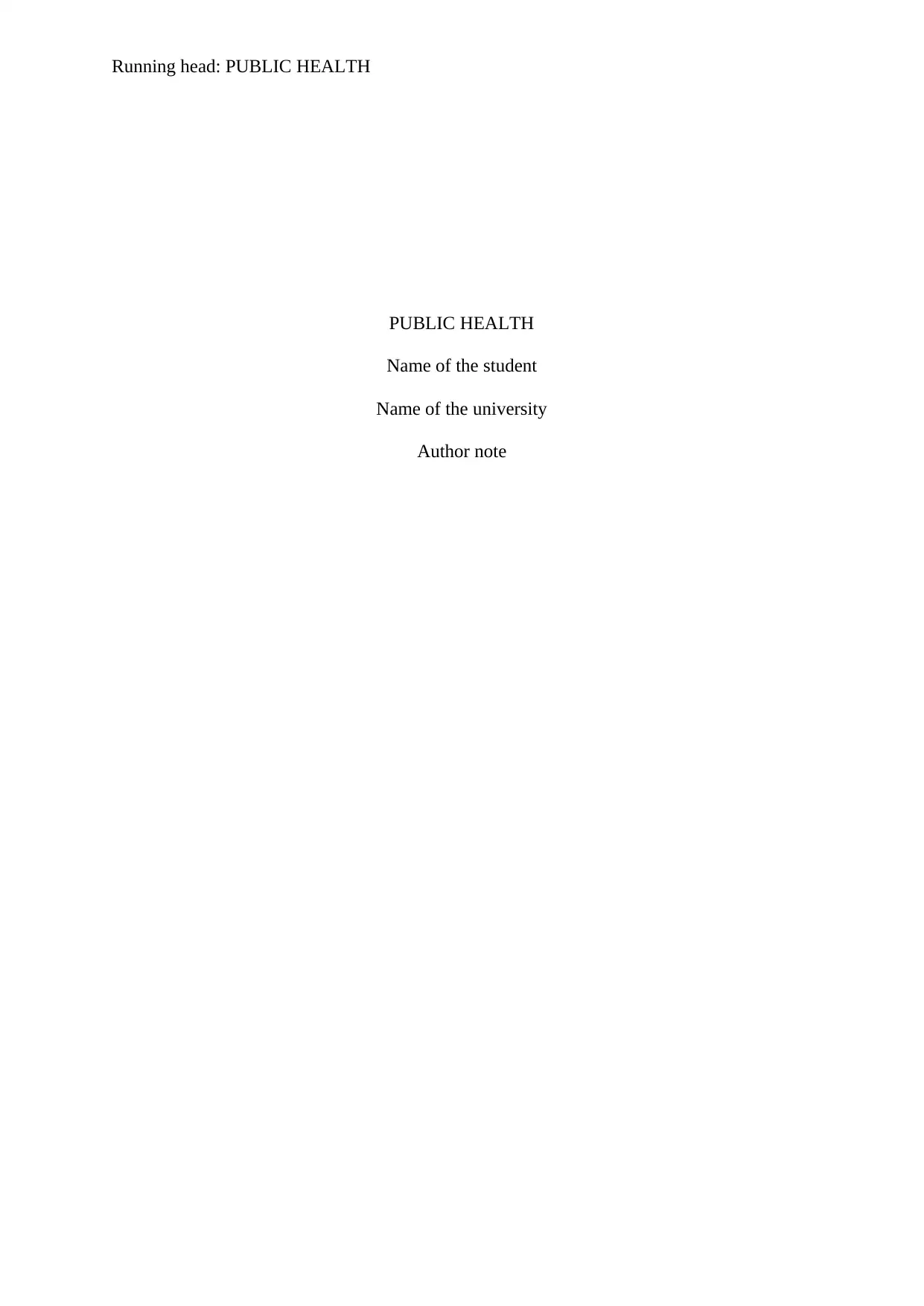
Running head: PUBLIC HEALTH
PUBLIC HEALTH
Name of the student
Name of the university
Author note
PUBLIC HEALTH
Name of the student
Name of the university
Author note
Secure Best Marks with AI Grader
Need help grading? Try our AI Grader for instant feedback on your assignments.
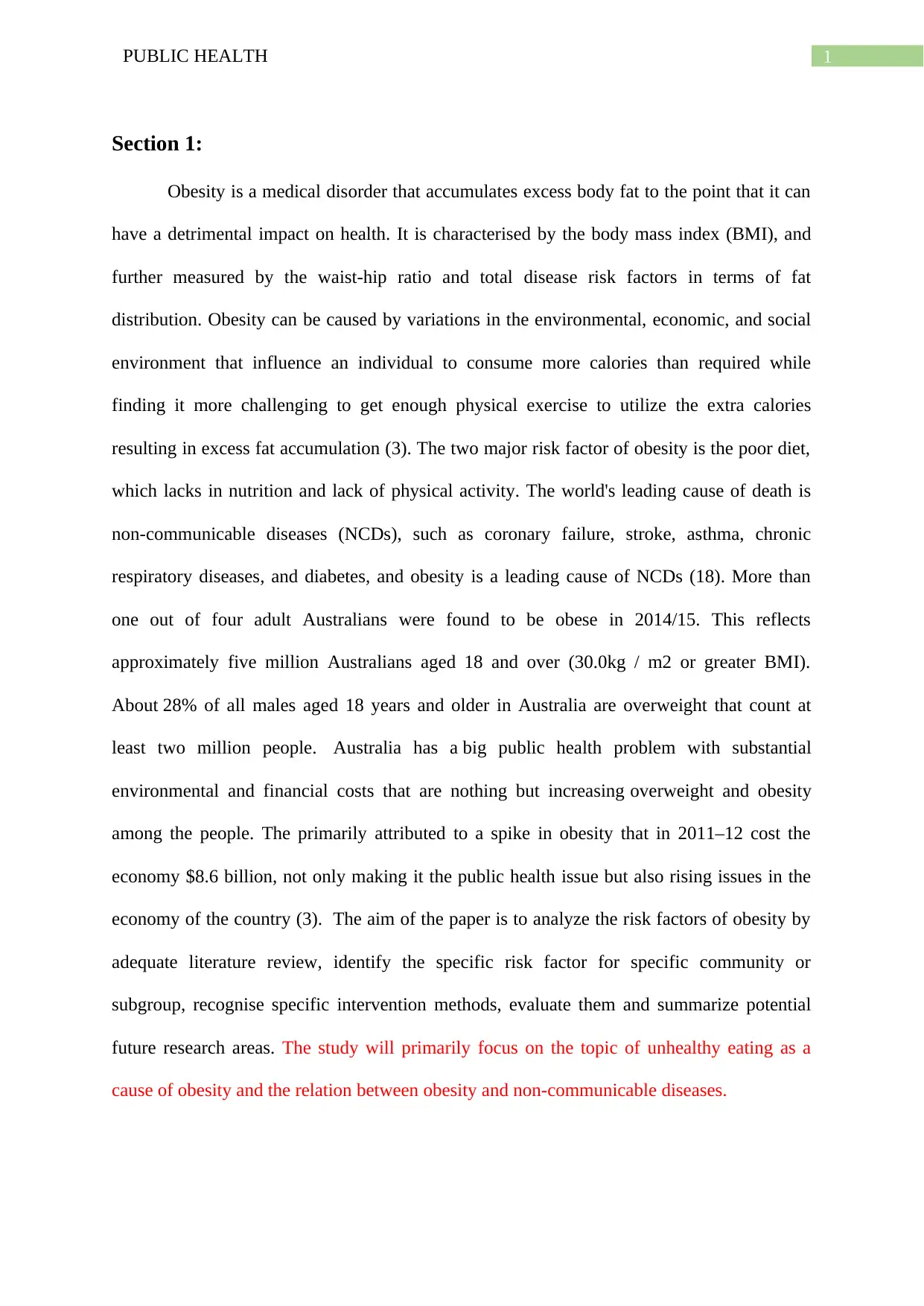
1PUBLIC HEALTH
Section 1:
Obesity is a medical disorder that accumulates excess body fat to the point that it can
have a detrimental impact on health. It is characterised by the body mass index (BMI), and
further measured by the waist-hip ratio and total disease risk factors in terms of fat
distribution. Obesity can be caused by variations in the environmental, economic, and social
environment that influence an individual to consume more calories than required while
finding it more challenging to get enough physical exercise to utilize the extra calories
resulting in excess fat accumulation (3). The two major risk factor of obesity is the poor diet,
which lacks in nutrition and lack of physical activity. The world's leading cause of death is
non-communicable diseases (NCDs), such as coronary failure, stroke, asthma, chronic
respiratory diseases, and diabetes, and obesity is a leading cause of NCDs (18). More than
one out of four adult Australians were found to be obese in 2014/15. This reflects
approximately five million Australians aged 18 and over (30.0kg / m2 or greater BMI).
About 28% of all males aged 18 years and older in Australia are overweight that count at
least two million people. Australia has a big public health problem with substantial
environmental and financial costs that are nothing but increasing overweight and obesity
among the people. The primarily attributed to a spike in obesity that in 2011–12 cost the
economy $8.6 billion, not only making it the public health issue but also rising issues in the
economy of the country (3). The aim of the paper is to analyze the risk factors of obesity by
adequate literature review, identify the specific risk factor for specific community or
subgroup, recognise specific intervention methods, evaluate them and summarize potential
future research areas. The study will primarily focus on the topic of unhealthy eating as a
cause of obesity and the relation between obesity and non-communicable diseases.
Section 1:
Obesity is a medical disorder that accumulates excess body fat to the point that it can
have a detrimental impact on health. It is characterised by the body mass index (BMI), and
further measured by the waist-hip ratio and total disease risk factors in terms of fat
distribution. Obesity can be caused by variations in the environmental, economic, and social
environment that influence an individual to consume more calories than required while
finding it more challenging to get enough physical exercise to utilize the extra calories
resulting in excess fat accumulation (3). The two major risk factor of obesity is the poor diet,
which lacks in nutrition and lack of physical activity. The world's leading cause of death is
non-communicable diseases (NCDs), such as coronary failure, stroke, asthma, chronic
respiratory diseases, and diabetes, and obesity is a leading cause of NCDs (18). More than
one out of four adult Australians were found to be obese in 2014/15. This reflects
approximately five million Australians aged 18 and over (30.0kg / m2 or greater BMI).
About 28% of all males aged 18 years and older in Australia are overweight that count at
least two million people. Australia has a big public health problem with substantial
environmental and financial costs that are nothing but increasing overweight and obesity
among the people. The primarily attributed to a spike in obesity that in 2011–12 cost the
economy $8.6 billion, not only making it the public health issue but also rising issues in the
economy of the country (3). The aim of the paper is to analyze the risk factors of obesity by
adequate literature review, identify the specific risk factor for specific community or
subgroup, recognise specific intervention methods, evaluate them and summarize potential
future research areas. The study will primarily focus on the topic of unhealthy eating as a
cause of obesity and the relation between obesity and non-communicable diseases.
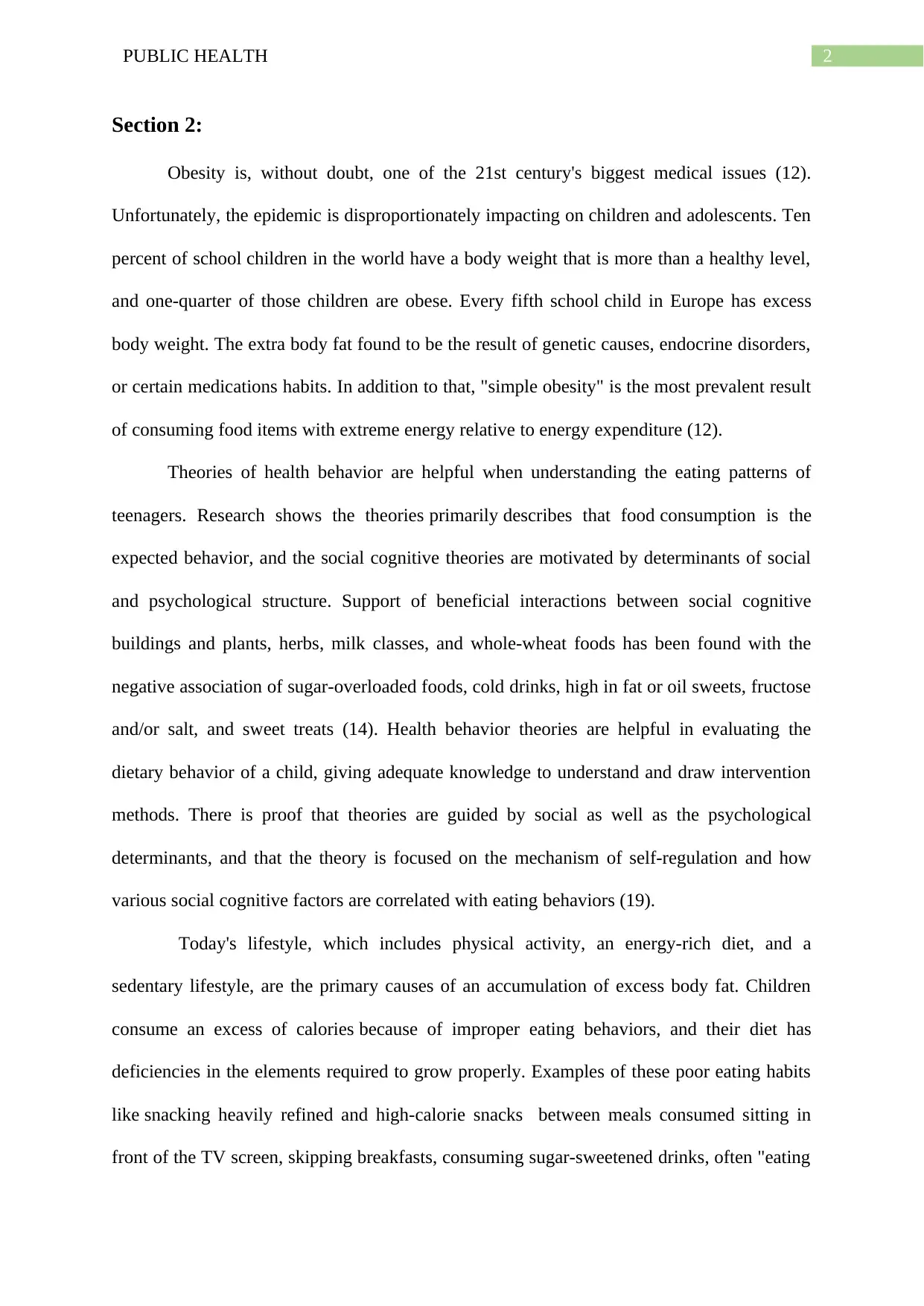
2PUBLIC HEALTH
Section 2:
Obesity is, without doubt, one of the 21st century's biggest medical issues (12).
Unfortunately, the epidemic is disproportionately impacting on children and adolescents. Ten
percent of school children in the world have a body weight that is more than a healthy level,
and one-quarter of those children are obese. Every fifth school child in Europe has excess
body weight. The extra body fat found to be the result of genetic causes, endocrine disorders,
or certain medications habits. In addition to that, "simple obesity" is the most prevalent result
of consuming food items with extreme energy relative to energy expenditure (12).
Theories of health behavior are helpful when understanding the eating patterns of
teenagers. Research shows the theories primarily describes that food consumption is the
expected behavior, and the social cognitive theories are motivated by determinants of social
and psychological structure. Support of beneficial interactions between social cognitive
buildings and plants, herbs, milk classes, and whole-wheat foods has been found with the
negative association of sugar-overloaded foods, cold drinks, high in fat or oil sweets, fructose
and/or salt, and sweet treats (14). Health behavior theories are helpful in evaluating the
dietary behavior of a child, giving adequate knowledge to understand and draw intervention
methods. There is proof that theories are guided by social as well as the psychological
determinants, and that the theory is focused on the mechanism of self-regulation and how
various social cognitive factors are correlated with eating behaviors (19).
Today's lifestyle, which includes physical activity, an energy-rich diet, and a
sedentary lifestyle, are the primary causes of an accumulation of excess body fat. Children
consume an excess of calories because of improper eating behaviors, and their diet has
deficiencies in the elements required to grow properly. Examples of these poor eating habits
like snacking heavily refined and high-calorie snacks between meals consumed sitting in
front of the TV screen, skipping breakfasts, consuming sugar-sweetened drinks, often "eating
Section 2:
Obesity is, without doubt, one of the 21st century's biggest medical issues (12).
Unfortunately, the epidemic is disproportionately impacting on children and adolescents. Ten
percent of school children in the world have a body weight that is more than a healthy level,
and one-quarter of those children are obese. Every fifth school child in Europe has excess
body weight. The extra body fat found to be the result of genetic causes, endocrine disorders,
or certain medications habits. In addition to that, "simple obesity" is the most prevalent result
of consuming food items with extreme energy relative to energy expenditure (12).
Theories of health behavior are helpful when understanding the eating patterns of
teenagers. Research shows the theories primarily describes that food consumption is the
expected behavior, and the social cognitive theories are motivated by determinants of social
and psychological structure. Support of beneficial interactions between social cognitive
buildings and plants, herbs, milk classes, and whole-wheat foods has been found with the
negative association of sugar-overloaded foods, cold drinks, high in fat or oil sweets, fructose
and/or salt, and sweet treats (14). Health behavior theories are helpful in evaluating the
dietary behavior of a child, giving adequate knowledge to understand and draw intervention
methods. There is proof that theories are guided by social as well as the psychological
determinants, and that the theory is focused on the mechanism of self-regulation and how
various social cognitive factors are correlated with eating behaviors (19).
Today's lifestyle, which includes physical activity, an energy-rich diet, and a
sedentary lifestyle, are the primary causes of an accumulation of excess body fat. Children
consume an excess of calories because of improper eating behaviors, and their diet has
deficiencies in the elements required to grow properly. Examples of these poor eating habits
like snacking heavily refined and high-calorie snacks between meals consumed sitting in
front of the TV screen, skipping breakfasts, consuming sugar-sweetened drinks, often "eating
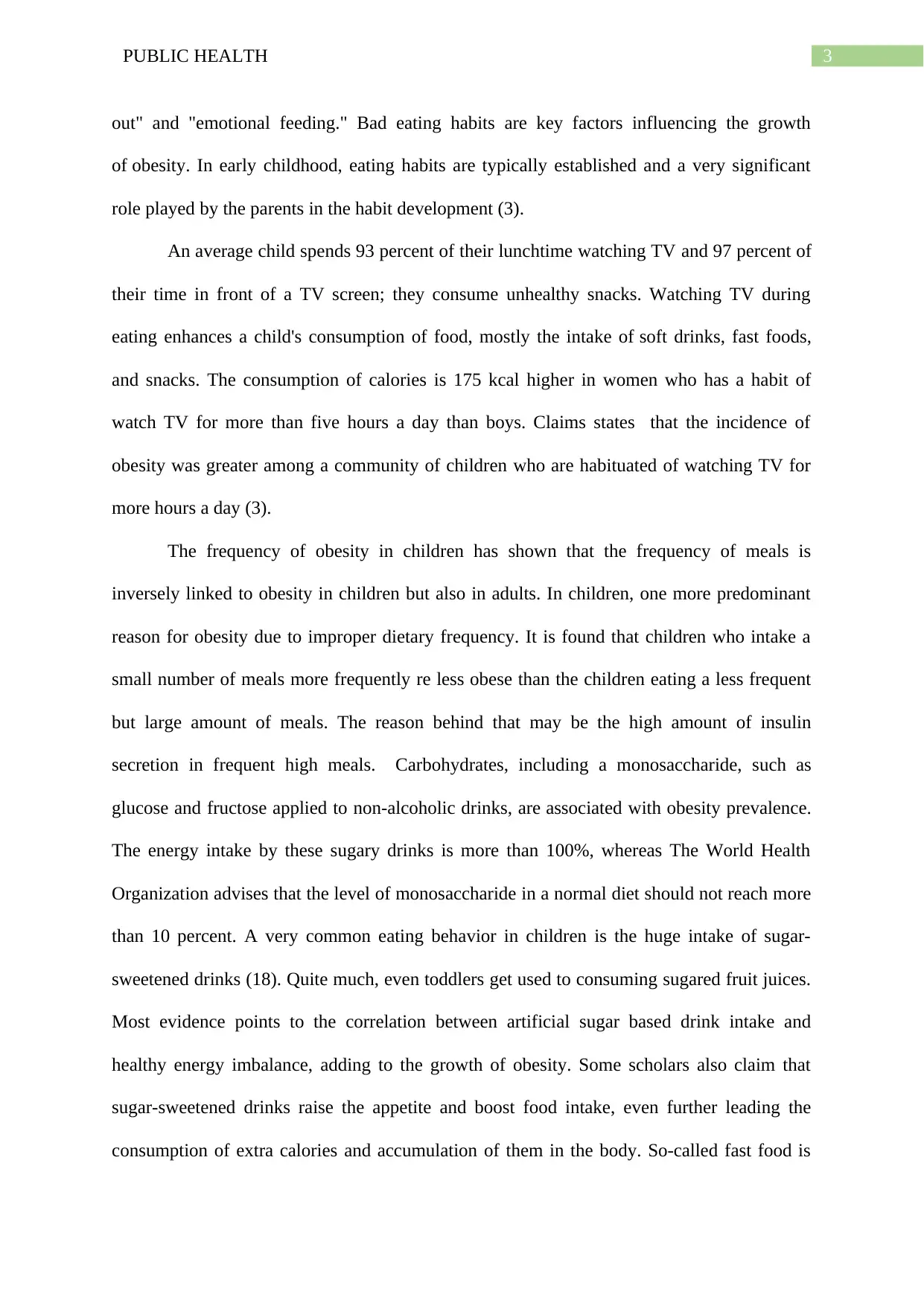
3PUBLIC HEALTH
out" and "emotional feeding." Bad eating habits are key factors influencing the growth
of obesity. In early childhood, eating habits are typically established and a very significant
role played by the parents in the habit development (3).
An average child spends 93 percent of their lunchtime watching TV and 97 percent of
their time in front of a TV screen; they consume unhealthy snacks. Watching TV during
eating enhances a child's consumption of food, mostly the intake of soft drinks, fast foods,
and snacks. The consumption of calories is 175 kcal higher in women who has a habit of
watch TV for more than five hours a day than boys. Claims states that the incidence of
obesity was greater among a community of children who are habituated of watching TV for
more hours a day (3).
The frequency of obesity in children has shown that the frequency of meals is
inversely linked to obesity in children but also in adults. In children, one more predominant
reason for obesity due to improper dietary frequency. It is found that children who intake a
small number of meals more frequently re less obese than the children eating a less frequent
but large amount of meals. The reason behind that may be the high amount of insulin
secretion in frequent high meals. Carbohydrates, including a monosaccharide, such as
glucose and fructose applied to non-alcoholic drinks, are associated with obesity prevalence.
The energy intake by these sugary drinks is more than 100%, whereas The World Health
Organization advises that the level of monosaccharide in a normal diet should not reach more
than 10 percent. A very common eating behavior in children is the huge intake of sugar-
sweetened drinks (18). Quite much, even toddlers get used to consuming sugared fruit juices.
Most evidence points to the correlation between artificial sugar based drink intake and
healthy energy imbalance, adding to the growth of obesity. Some scholars also claim that
sugar-sweetened drinks raise the appetite and boost food intake, even further leading the
consumption of extra calories and accumulation of them in the body. So-called fast food is
out" and "emotional feeding." Bad eating habits are key factors influencing the growth
of obesity. In early childhood, eating habits are typically established and a very significant
role played by the parents in the habit development (3).
An average child spends 93 percent of their lunchtime watching TV and 97 percent of
their time in front of a TV screen; they consume unhealthy snacks. Watching TV during
eating enhances a child's consumption of food, mostly the intake of soft drinks, fast foods,
and snacks. The consumption of calories is 175 kcal higher in women who has a habit of
watch TV for more than five hours a day than boys. Claims states that the incidence of
obesity was greater among a community of children who are habituated of watching TV for
more hours a day (3).
The frequency of obesity in children has shown that the frequency of meals is
inversely linked to obesity in children but also in adults. In children, one more predominant
reason for obesity due to improper dietary frequency. It is found that children who intake a
small number of meals more frequently re less obese than the children eating a less frequent
but large amount of meals. The reason behind that may be the high amount of insulin
secretion in frequent high meals. Carbohydrates, including a monosaccharide, such as
glucose and fructose applied to non-alcoholic drinks, are associated with obesity prevalence.
The energy intake by these sugary drinks is more than 100%, whereas The World Health
Organization advises that the level of monosaccharide in a normal diet should not reach more
than 10 percent. A very common eating behavior in children is the huge intake of sugar-
sweetened drinks (18). Quite much, even toddlers get used to consuming sugared fruit juices.
Most evidence points to the correlation between artificial sugar based drink intake and
healthy energy imbalance, adding to the growth of obesity. Some scholars also claim that
sugar-sweetened drinks raise the appetite and boost food intake, even further leading the
consumption of extra calories and accumulation of them in the body. So-called fast food is
Secure Best Marks with AI Grader
Need help grading? Try our AI Grader for instant feedback on your assignments.
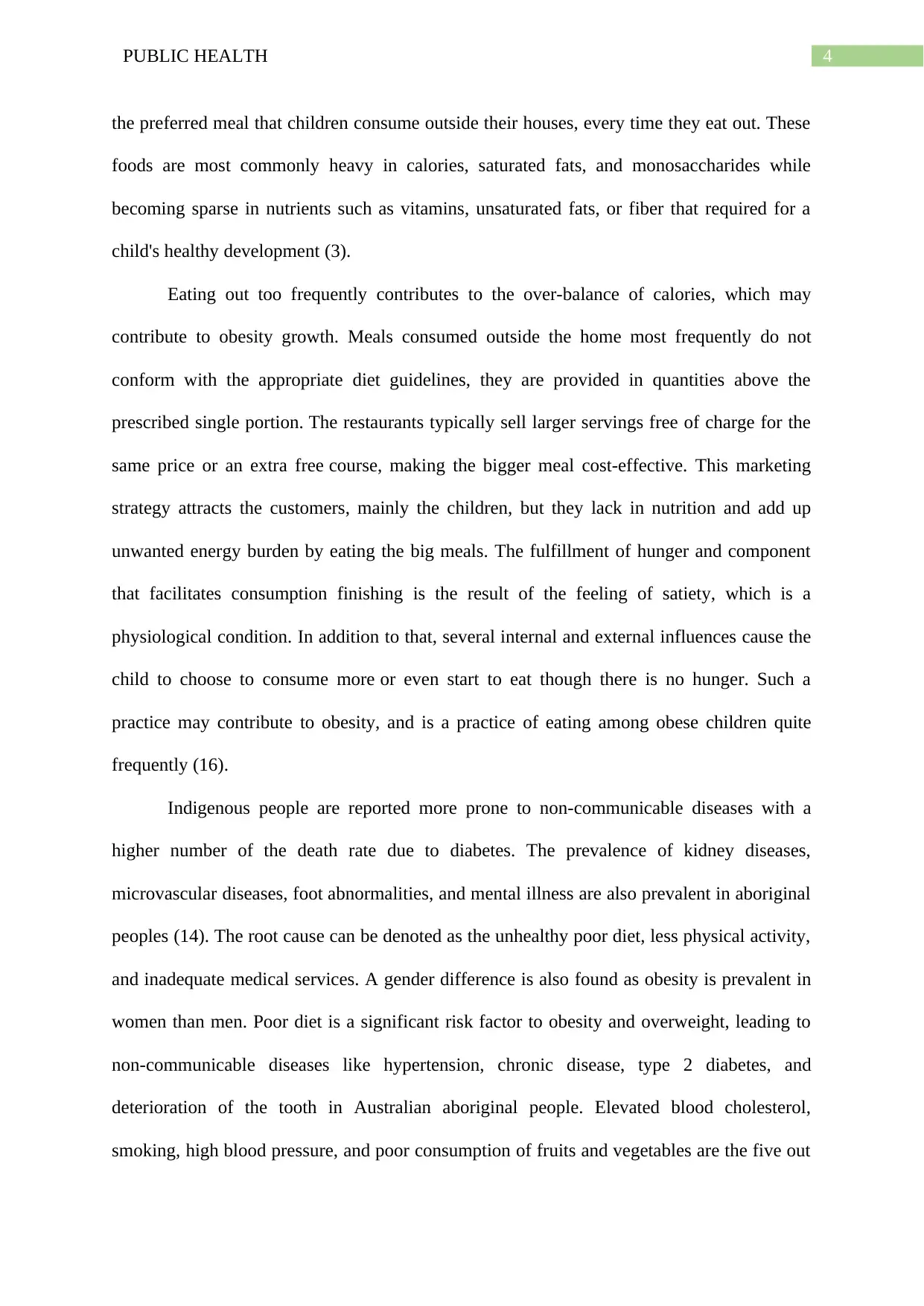
4PUBLIC HEALTH
the preferred meal that children consume outside their houses, every time they eat out. These
foods are most commonly heavy in calories, saturated fats, and monosaccharides while
becoming sparse in nutrients such as vitamins, unsaturated fats, or fiber that required for a
child's healthy development (3).
Eating out too frequently contributes to the over-balance of calories, which may
contribute to obesity growth. Meals consumed outside the home most frequently do not
conform with the appropriate diet guidelines, they are provided in quantities above the
prescribed single portion. The restaurants typically sell larger servings free of charge for the
same price or an extra free course, making the bigger meal cost-effective. This marketing
strategy attracts the customers, mainly the children, but they lack in nutrition and add up
unwanted energy burden by eating the big meals. The fulfillment of hunger and component
that facilitates consumption finishing is the result of the feeling of satiety, which is a
physiological condition. In addition to that, several internal and external influences cause the
child to choose to consume more or even start to eat though there is no hunger. Such a
practice may contribute to obesity, and is a practice of eating among obese children quite
frequently (16).
Indigenous people are reported more prone to non-communicable diseases with a
higher number of the death rate due to diabetes. The prevalence of kidney diseases,
microvascular diseases, foot abnormalities, and mental illness are also prevalent in aboriginal
peoples (14). The root cause can be denoted as the unhealthy poor diet, less physical activity,
and inadequate medical services. A gender difference is also found as obesity is prevalent in
women than men. Poor diet is a significant risk factor to obesity and overweight, leading to
non-communicable diseases like hypertension, chronic disease, type 2 diabetes, and
deterioration of the tooth in Australian aboriginal people. Elevated blood cholesterol,
smoking, high blood pressure, and poor consumption of fruits and vegetables are the five out
the preferred meal that children consume outside their houses, every time they eat out. These
foods are most commonly heavy in calories, saturated fats, and monosaccharides while
becoming sparse in nutrients such as vitamins, unsaturated fats, or fiber that required for a
child's healthy development (3).
Eating out too frequently contributes to the over-balance of calories, which may
contribute to obesity growth. Meals consumed outside the home most frequently do not
conform with the appropriate diet guidelines, they are provided in quantities above the
prescribed single portion. The restaurants typically sell larger servings free of charge for the
same price or an extra free course, making the bigger meal cost-effective. This marketing
strategy attracts the customers, mainly the children, but they lack in nutrition and add up
unwanted energy burden by eating the big meals. The fulfillment of hunger and component
that facilitates consumption finishing is the result of the feeling of satiety, which is a
physiological condition. In addition to that, several internal and external influences cause the
child to choose to consume more or even start to eat though there is no hunger. Such a
practice may contribute to obesity, and is a practice of eating among obese children quite
frequently (16).
Indigenous people are reported more prone to non-communicable diseases with a
higher number of the death rate due to diabetes. The prevalence of kidney diseases,
microvascular diseases, foot abnormalities, and mental illness are also prevalent in aboriginal
peoples (14). The root cause can be denoted as the unhealthy poor diet, less physical activity,
and inadequate medical services. A gender difference is also found as obesity is prevalent in
women than men. Poor diet is a significant risk factor to obesity and overweight, leading to
non-communicable diseases like hypertension, chronic disease, type 2 diabetes, and
deterioration of the tooth in Australian aboriginal people. Elevated blood cholesterol,
smoking, high blood pressure, and poor consumption of fruits and vegetables are the five out
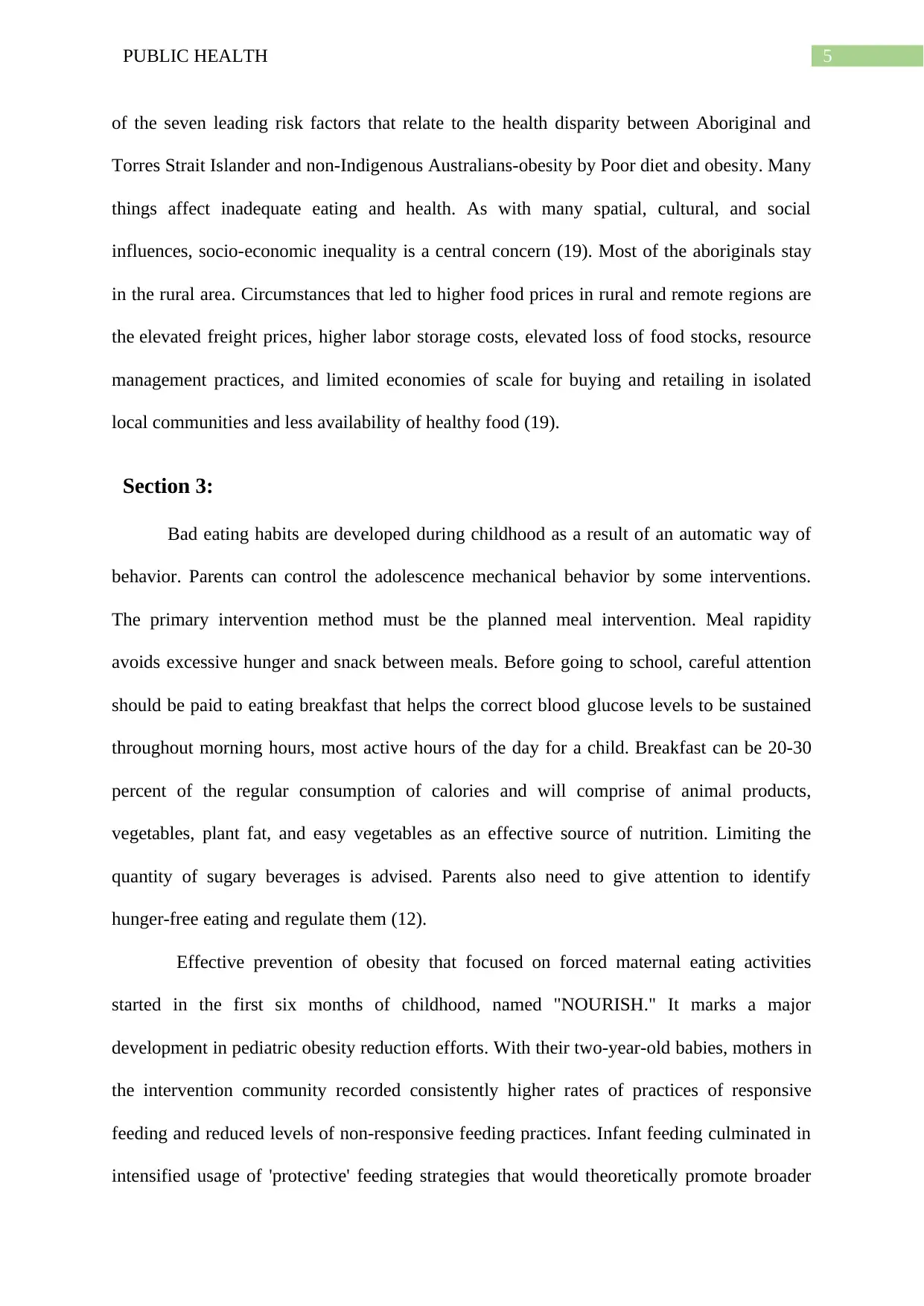
5PUBLIC HEALTH
of the seven leading risk factors that relate to the health disparity between Aboriginal and
Torres Strait Islander and non-Indigenous Australians-obesity by Poor diet and obesity. Many
things affect inadequate eating and health. As with many spatial, cultural, and social
influences, socio-economic inequality is a central concern (19). Most of the aboriginals stay
in the rural area. Circumstances that led to higher food prices in rural and remote regions are
the elevated freight prices, higher labor storage costs, elevated loss of food stocks, resource
management practices, and limited economies of scale for buying and retailing in isolated
local communities and less availability of healthy food (19).
Section 3:
Bad eating habits are developed during childhood as a result of an automatic way of
behavior. Parents can control the adolescence mechanical behavior by some interventions.
The primary intervention method must be the planned meal intervention. Meal rapidity
avoids excessive hunger and snack between meals. Before going to school, careful attention
should be paid to eating breakfast that helps the correct blood glucose levels to be sustained
throughout morning hours, most active hours of the day for a child. Breakfast can be 20-30
percent of the regular consumption of calories and will comprise of animal products,
vegetables, plant fat, and easy vegetables as an effective source of nutrition. Limiting the
quantity of sugary beverages is advised. Parents also need to give attention to identify
hunger-free eating and regulate them (12).
Effective prevention of obesity that focused on forced maternal eating activities
started in the first six months of childhood, named "NOURISH." It marks a major
development in pediatric obesity reduction efforts. With their two-year-old babies, mothers in
the intervention community recorded consistently higher rates of practices of responsive
feeding and reduced levels of non-responsive feeding practices. Infant feeding culminated in
intensified usage of 'protective' feeding strategies that would theoretically promote broader
of the seven leading risk factors that relate to the health disparity between Aboriginal and
Torres Strait Islander and non-Indigenous Australians-obesity by Poor diet and obesity. Many
things affect inadequate eating and health. As with many spatial, cultural, and social
influences, socio-economic inequality is a central concern (19). Most of the aboriginals stay
in the rural area. Circumstances that led to higher food prices in rural and remote regions are
the elevated freight prices, higher labor storage costs, elevated loss of food stocks, resource
management practices, and limited economies of scale for buying and retailing in isolated
local communities and less availability of healthy food (19).
Section 3:
Bad eating habits are developed during childhood as a result of an automatic way of
behavior. Parents can control the adolescence mechanical behavior by some interventions.
The primary intervention method must be the planned meal intervention. Meal rapidity
avoids excessive hunger and snack between meals. Before going to school, careful attention
should be paid to eating breakfast that helps the correct blood glucose levels to be sustained
throughout morning hours, most active hours of the day for a child. Breakfast can be 20-30
percent of the regular consumption of calories and will comprise of animal products,
vegetables, plant fat, and easy vegetables as an effective source of nutrition. Limiting the
quantity of sugary beverages is advised. Parents also need to give attention to identify
hunger-free eating and regulate them (12).
Effective prevention of obesity that focused on forced maternal eating activities
started in the first six months of childhood, named "NOURISH." It marks a major
development in pediatric obesity reduction efforts. With their two-year-old babies, mothers in
the intervention community recorded consistently higher rates of practices of responsive
feeding and reduced levels of non-responsive feeding practices. Infant feeding culminated in
intensified usage of 'protective' feeding strategies that would theoretically promote broader
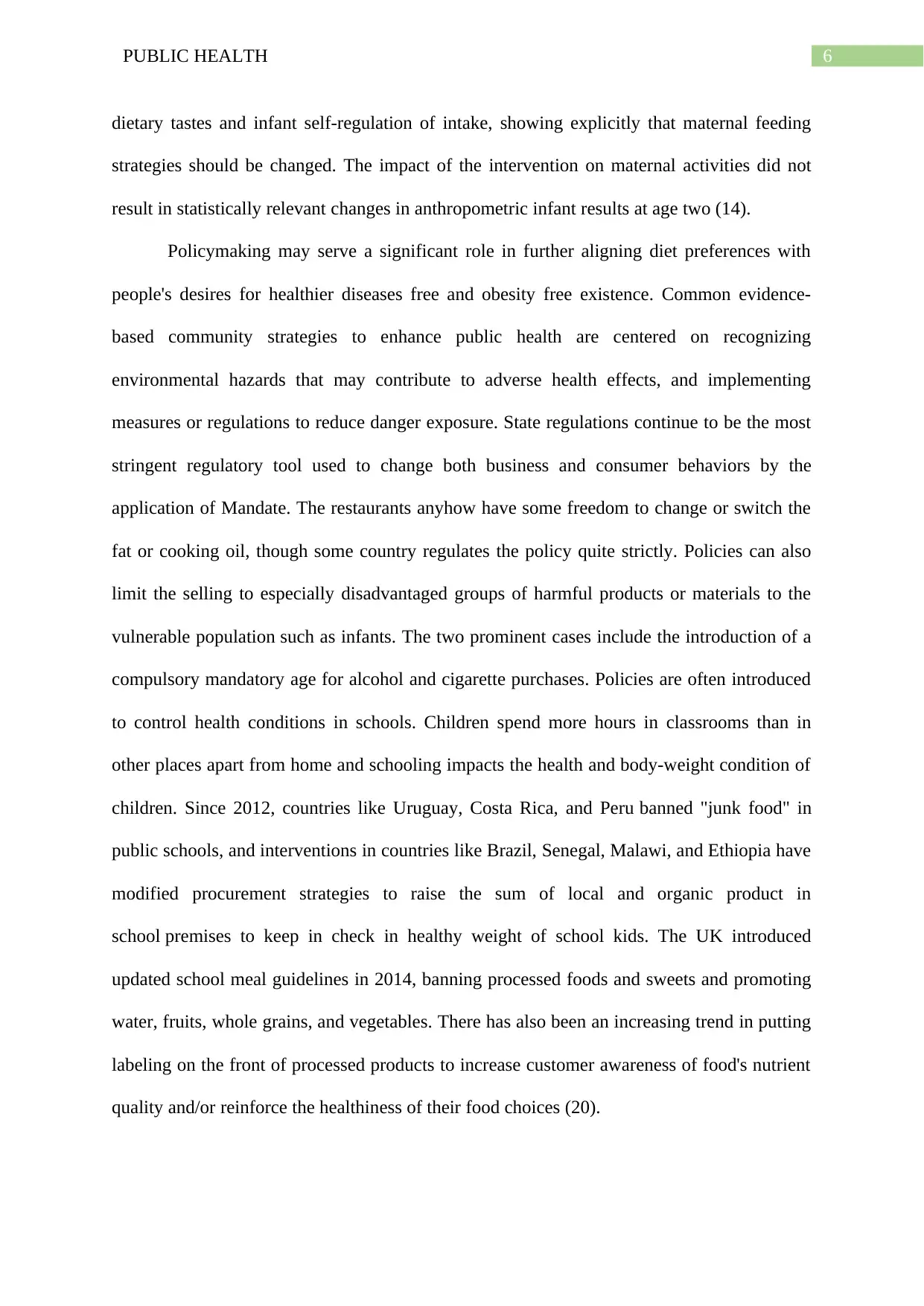
6PUBLIC HEALTH
dietary tastes and infant self-regulation of intake, showing explicitly that maternal feeding
strategies should be changed. The impact of the intervention on maternal activities did not
result in statistically relevant changes in anthropometric infant results at age two (14).
Policymaking may serve a significant role in further aligning diet preferences with
people's desires for healthier diseases free and obesity free existence. Common evidence-
based community strategies to enhance public health are centered on recognizing
environmental hazards that may contribute to adverse health effects, and implementing
measures or regulations to reduce danger exposure. State regulations continue to be the most
stringent regulatory tool used to change both business and consumer behaviors by the
application of Mandate. The restaurants anyhow have some freedom to change or switch the
fat or cooking oil, though some country regulates the policy quite strictly. Policies can also
limit the selling to especially disadvantaged groups of harmful products or materials to the
vulnerable population such as infants. The two prominent cases include the introduction of a
compulsory mandatory age for alcohol and cigarette purchases. Policies are often introduced
to control health conditions in schools. Children spend more hours in classrooms than in
other places apart from home and schooling impacts the health and body-weight condition of
children. Since 2012, countries like Uruguay, Costa Rica, and Peru banned "junk food" in
public schools, and interventions in countries like Brazil, Senegal, Malawi, and Ethiopia have
modified procurement strategies to raise the sum of local and organic product in
school premises to keep in check in healthy weight of school kids. The UK introduced
updated school meal guidelines in 2014, banning processed foods and sweets and promoting
water, fruits, whole grains, and vegetables. There has also been an increasing trend in putting
labeling on the front of processed products to increase customer awareness of food's nutrient
quality and/or reinforce the healthiness of their food choices (20).
dietary tastes and infant self-regulation of intake, showing explicitly that maternal feeding
strategies should be changed. The impact of the intervention on maternal activities did not
result in statistically relevant changes in anthropometric infant results at age two (14).
Policymaking may serve a significant role in further aligning diet preferences with
people's desires for healthier diseases free and obesity free existence. Common evidence-
based community strategies to enhance public health are centered on recognizing
environmental hazards that may contribute to adverse health effects, and implementing
measures or regulations to reduce danger exposure. State regulations continue to be the most
stringent regulatory tool used to change both business and consumer behaviors by the
application of Mandate. The restaurants anyhow have some freedom to change or switch the
fat or cooking oil, though some country regulates the policy quite strictly. Policies can also
limit the selling to especially disadvantaged groups of harmful products or materials to the
vulnerable population such as infants. The two prominent cases include the introduction of a
compulsory mandatory age for alcohol and cigarette purchases. Policies are often introduced
to control health conditions in schools. Children spend more hours in classrooms than in
other places apart from home and schooling impacts the health and body-weight condition of
children. Since 2012, countries like Uruguay, Costa Rica, and Peru banned "junk food" in
public schools, and interventions in countries like Brazil, Senegal, Malawi, and Ethiopia have
modified procurement strategies to raise the sum of local and organic product in
school premises to keep in check in healthy weight of school kids. The UK introduced
updated school meal guidelines in 2014, banning processed foods and sweets and promoting
water, fruits, whole grains, and vegetables. There has also been an increasing trend in putting
labeling on the front of processed products to increase customer awareness of food's nutrient
quality and/or reinforce the healthiness of their food choices (20).
Paraphrase This Document
Need a fresh take? Get an instant paraphrase of this document with our AI Paraphraser
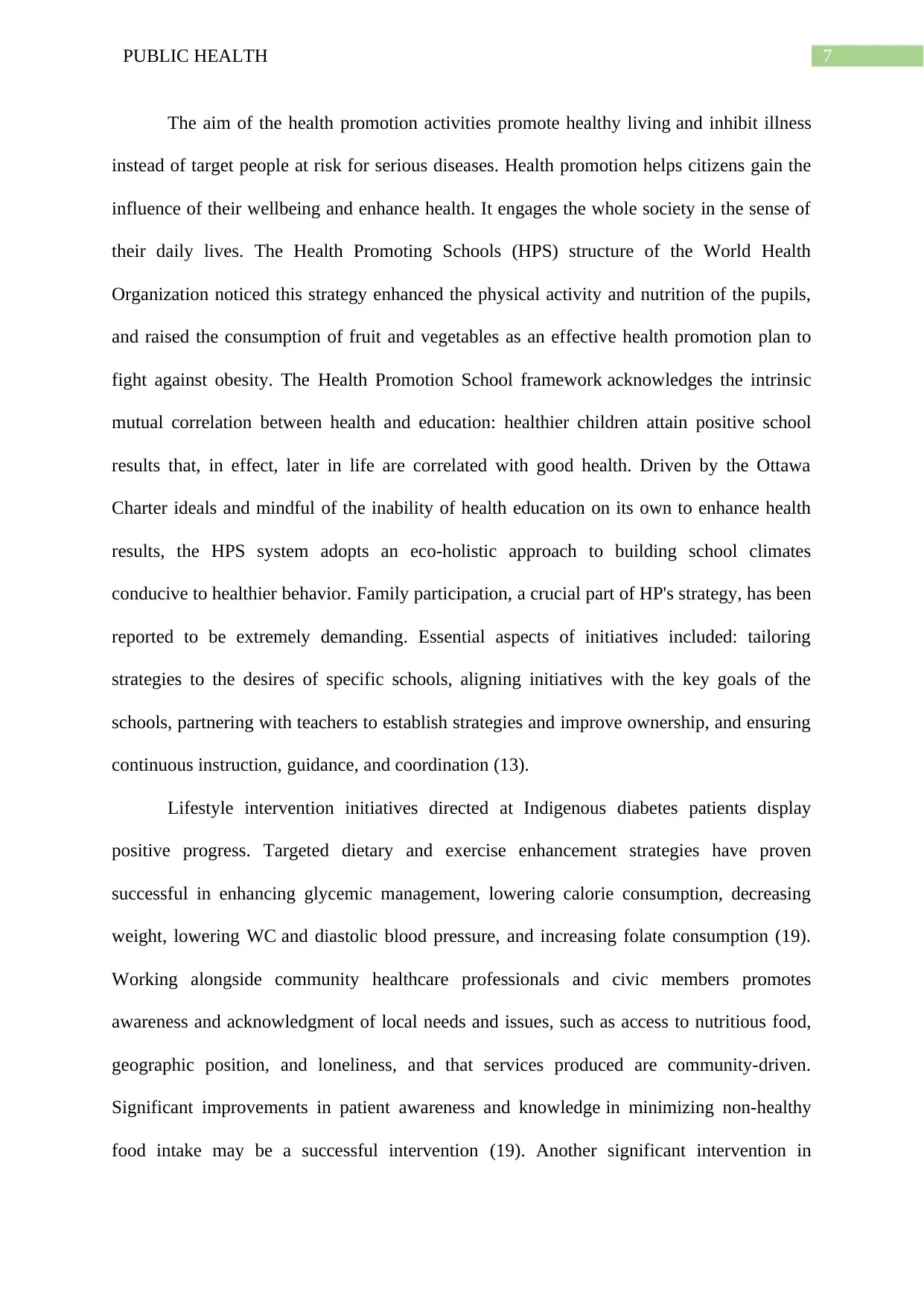
7PUBLIC HEALTH
The aim of the health promotion activities promote healthy living and inhibit illness
instead of target people at risk for serious diseases. Health promotion helps citizens gain the
influence of their wellbeing and enhance health. It engages the whole society in the sense of
their daily lives. The Health Promoting Schools (HPS) structure of the World Health
Organization noticed this strategy enhanced the physical activity and nutrition of the pupils,
and raised the consumption of fruit and vegetables as an effective health promotion plan to
fight against obesity. The Health Promotion School framework acknowledges the intrinsic
mutual correlation between health and education: healthier children attain positive school
results that, in effect, later in life are correlated with good health. Driven by the Ottawa
Charter ideals and mindful of the inability of health education on its own to enhance health
results, the HPS system adopts an eco-holistic approach to building school climates
conducive to healthier behavior. Family participation, a crucial part of HP's strategy, has been
reported to be extremely demanding. Essential aspects of initiatives included: tailoring
strategies to the desires of specific schools, aligning initiatives with the key goals of the
schools, partnering with teachers to establish strategies and improve ownership, and ensuring
continuous instruction, guidance, and coordination (13).
Lifestyle intervention initiatives directed at Indigenous diabetes patients display
positive progress. Targeted dietary and exercise enhancement strategies have proven
successful in enhancing glycemic management, lowering calorie consumption, decreasing
weight, lowering WC and diastolic blood pressure, and increasing folate consumption (19).
Working alongside community healthcare professionals and civic members promotes
awareness and acknowledgment of local needs and issues, such as access to nutritious food,
geographic position, and loneliness, and that services produced are community-driven.
Significant improvements in patient awareness and knowledge in minimizing non-healthy
food intake may be a successful intervention (19). Another significant intervention in
The aim of the health promotion activities promote healthy living and inhibit illness
instead of target people at risk for serious diseases. Health promotion helps citizens gain the
influence of their wellbeing and enhance health. It engages the whole society in the sense of
their daily lives. The Health Promoting Schools (HPS) structure of the World Health
Organization noticed this strategy enhanced the physical activity and nutrition of the pupils,
and raised the consumption of fruit and vegetables as an effective health promotion plan to
fight against obesity. The Health Promotion School framework acknowledges the intrinsic
mutual correlation between health and education: healthier children attain positive school
results that, in effect, later in life are correlated with good health. Driven by the Ottawa
Charter ideals and mindful of the inability of health education on its own to enhance health
results, the HPS system adopts an eco-holistic approach to building school climates
conducive to healthier behavior. Family participation, a crucial part of HP's strategy, has been
reported to be extremely demanding. Essential aspects of initiatives included: tailoring
strategies to the desires of specific schools, aligning initiatives with the key goals of the
schools, partnering with teachers to establish strategies and improve ownership, and ensuring
continuous instruction, guidance, and coordination (13).
Lifestyle intervention initiatives directed at Indigenous diabetes patients display
positive progress. Targeted dietary and exercise enhancement strategies have proven
successful in enhancing glycemic management, lowering calorie consumption, decreasing
weight, lowering WC and diastolic blood pressure, and increasing folate consumption (19).
Working alongside community healthcare professionals and civic members promotes
awareness and acknowledgment of local needs and issues, such as access to nutritious food,
geographic position, and loneliness, and that services produced are community-driven.
Significant improvements in patient awareness and knowledge in minimizing non-healthy
food intake may be a successful intervention (19). Another significant intervention in
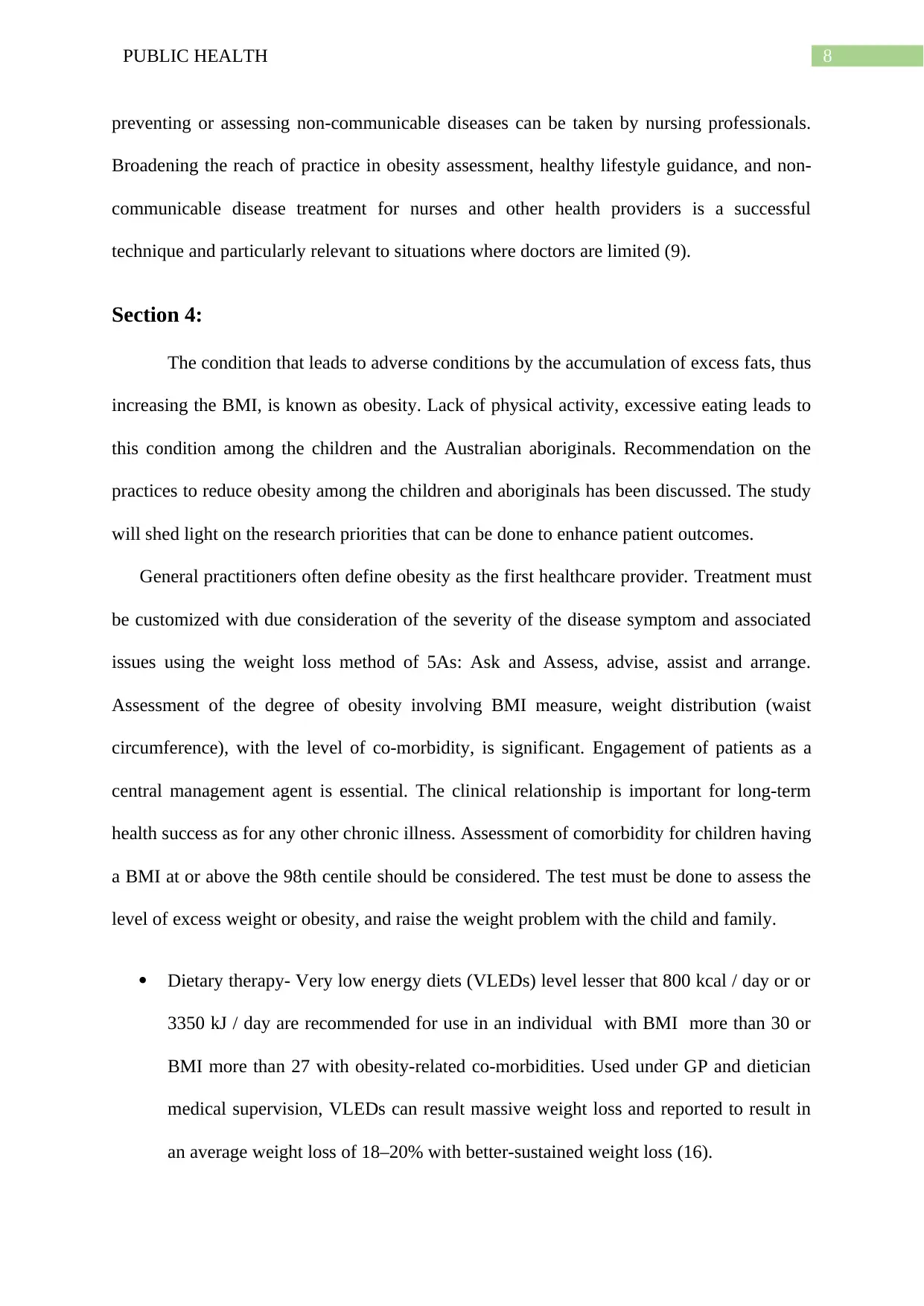
8PUBLIC HEALTH
preventing or assessing non-communicable diseases can be taken by nursing professionals.
Broadening the reach of practice in obesity assessment, healthy lifestyle guidance, and non-
communicable disease treatment for nurses and other health providers is a successful
technique and particularly relevant to situations where doctors are limited (9).
Section 4:
The condition that leads to adverse conditions by the accumulation of excess fats, thus
increasing the BMI, is known as obesity. Lack of physical activity, excessive eating leads to
this condition among the children and the Australian aboriginals. Recommendation on the
practices to reduce obesity among the children and aboriginals has been discussed. The study
will shed light on the research priorities that can be done to enhance patient outcomes.
General practitioners often define obesity as the first healthcare provider. Treatment must
be customized with due consideration of the severity of the disease symptom and associated
issues using the weight loss method of 5As: Ask and Assess, advise, assist and arrange.
Assessment of the degree of obesity involving BMI measure, weight distribution (waist
circumference), with the level of co-morbidity, is significant. Engagement of patients as a
central management agent is essential. The clinical relationship is important for long-term
health success as for any other chronic illness. Assessment of comorbidity for children having
a BMI at or above the 98th centile should be considered. The test must be done to assess the
level of excess weight or obesity, and raise the weight problem with the child and family.
Dietary therapy- Very low energy diets (VLEDs) level lesser that 800 kcal / day or or
3350 kJ / day are recommended for use in an individual with BMI more than 30 or
BMI more than 27 with obesity-related co-morbidities. Used under GP and dietician
medical supervision, VLEDs can result massive weight loss and reported to result in
an average weight loss of 18–20% with better-sustained weight loss (16).
preventing or assessing non-communicable diseases can be taken by nursing professionals.
Broadening the reach of practice in obesity assessment, healthy lifestyle guidance, and non-
communicable disease treatment for nurses and other health providers is a successful
technique and particularly relevant to situations where doctors are limited (9).
Section 4:
The condition that leads to adverse conditions by the accumulation of excess fats, thus
increasing the BMI, is known as obesity. Lack of physical activity, excessive eating leads to
this condition among the children and the Australian aboriginals. Recommendation on the
practices to reduce obesity among the children and aboriginals has been discussed. The study
will shed light on the research priorities that can be done to enhance patient outcomes.
General practitioners often define obesity as the first healthcare provider. Treatment must
be customized with due consideration of the severity of the disease symptom and associated
issues using the weight loss method of 5As: Ask and Assess, advise, assist and arrange.
Assessment of the degree of obesity involving BMI measure, weight distribution (waist
circumference), with the level of co-morbidity, is significant. Engagement of patients as a
central management agent is essential. The clinical relationship is important for long-term
health success as for any other chronic illness. Assessment of comorbidity for children having
a BMI at or above the 98th centile should be considered. The test must be done to assess the
level of excess weight or obesity, and raise the weight problem with the child and family.
Dietary therapy- Very low energy diets (VLEDs) level lesser that 800 kcal / day or or
3350 kJ / day are recommended for use in an individual with BMI more than 30 or
BMI more than 27 with obesity-related co-morbidities. Used under GP and dietician
medical supervision, VLEDs can result massive weight loss and reported to result in
an average weight loss of 18–20% with better-sustained weight loss (16).
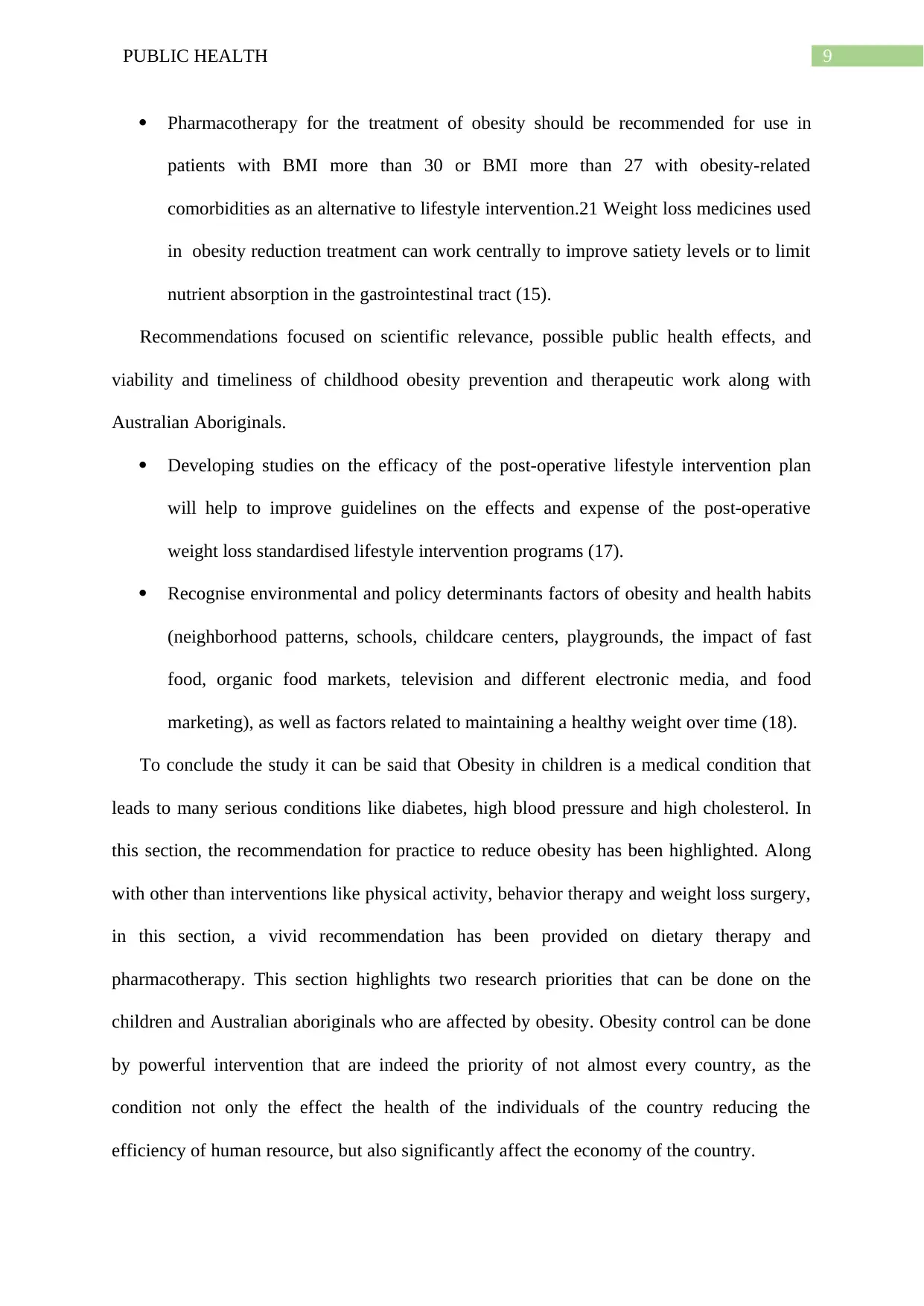
9PUBLIC HEALTH
Pharmacotherapy for the treatment of obesity should be recommended for use in
patients with BMI more than 30 or BMI more than 27 with obesity-related
comorbidities as an alternative to lifestyle intervention.21 Weight loss medicines used
in obesity reduction treatment can work centrally to improve satiety levels or to limit
nutrient absorption in the gastrointestinal tract (15).
Recommendations focused on scientific relevance, possible public health effects, and
viability and timeliness of childhood obesity prevention and therapeutic work along with
Australian Aboriginals.
Developing studies on the efficacy of the post-operative lifestyle intervention plan
will help to improve guidelines on the effects and expense of the post-operative
weight loss standardised lifestyle intervention programs (17).
Recognise environmental and policy determinants factors of obesity and health habits
(neighborhood patterns, schools, childcare centers, playgrounds, the impact of fast
food, organic food markets, television and different electronic media, and food
marketing), as well as factors related to maintaining a healthy weight over time (18).
To conclude the study it can be said that Obesity in children is a medical condition that
leads to many serious conditions like diabetes, high blood pressure and high cholesterol. In
this section, the recommendation for practice to reduce obesity has been highlighted. Along
with other than interventions like physical activity, behavior therapy and weight loss surgery,
in this section, a vivid recommendation has been provided on dietary therapy and
pharmacotherapy. This section highlights two research priorities that can be done on the
children and Australian aboriginals who are affected by obesity. Obesity control can be done
by powerful intervention that are indeed the priority of not almost every country, as the
condition not only the effect the health of the individuals of the country reducing the
efficiency of human resource, but also significantly affect the economy of the country.
Pharmacotherapy for the treatment of obesity should be recommended for use in
patients with BMI more than 30 or BMI more than 27 with obesity-related
comorbidities as an alternative to lifestyle intervention.21 Weight loss medicines used
in obesity reduction treatment can work centrally to improve satiety levels or to limit
nutrient absorption in the gastrointestinal tract (15).
Recommendations focused on scientific relevance, possible public health effects, and
viability and timeliness of childhood obesity prevention and therapeutic work along with
Australian Aboriginals.
Developing studies on the efficacy of the post-operative lifestyle intervention plan
will help to improve guidelines on the effects and expense of the post-operative
weight loss standardised lifestyle intervention programs (17).
Recognise environmental and policy determinants factors of obesity and health habits
(neighborhood patterns, schools, childcare centers, playgrounds, the impact of fast
food, organic food markets, television and different electronic media, and food
marketing), as well as factors related to maintaining a healthy weight over time (18).
To conclude the study it can be said that Obesity in children is a medical condition that
leads to many serious conditions like diabetes, high blood pressure and high cholesterol. In
this section, the recommendation for practice to reduce obesity has been highlighted. Along
with other than interventions like physical activity, behavior therapy and weight loss surgery,
in this section, a vivid recommendation has been provided on dietary therapy and
pharmacotherapy. This section highlights two research priorities that can be done on the
children and Australian aboriginals who are affected by obesity. Obesity control can be done
by powerful intervention that are indeed the priority of not almost every country, as the
condition not only the effect the health of the individuals of the country reducing the
efficiency of human resource, but also significantly affect the economy of the country.
Secure Best Marks with AI Grader
Need help grading? Try our AI Grader for instant feedback on your assignments.

10PUBLIC HEALTH
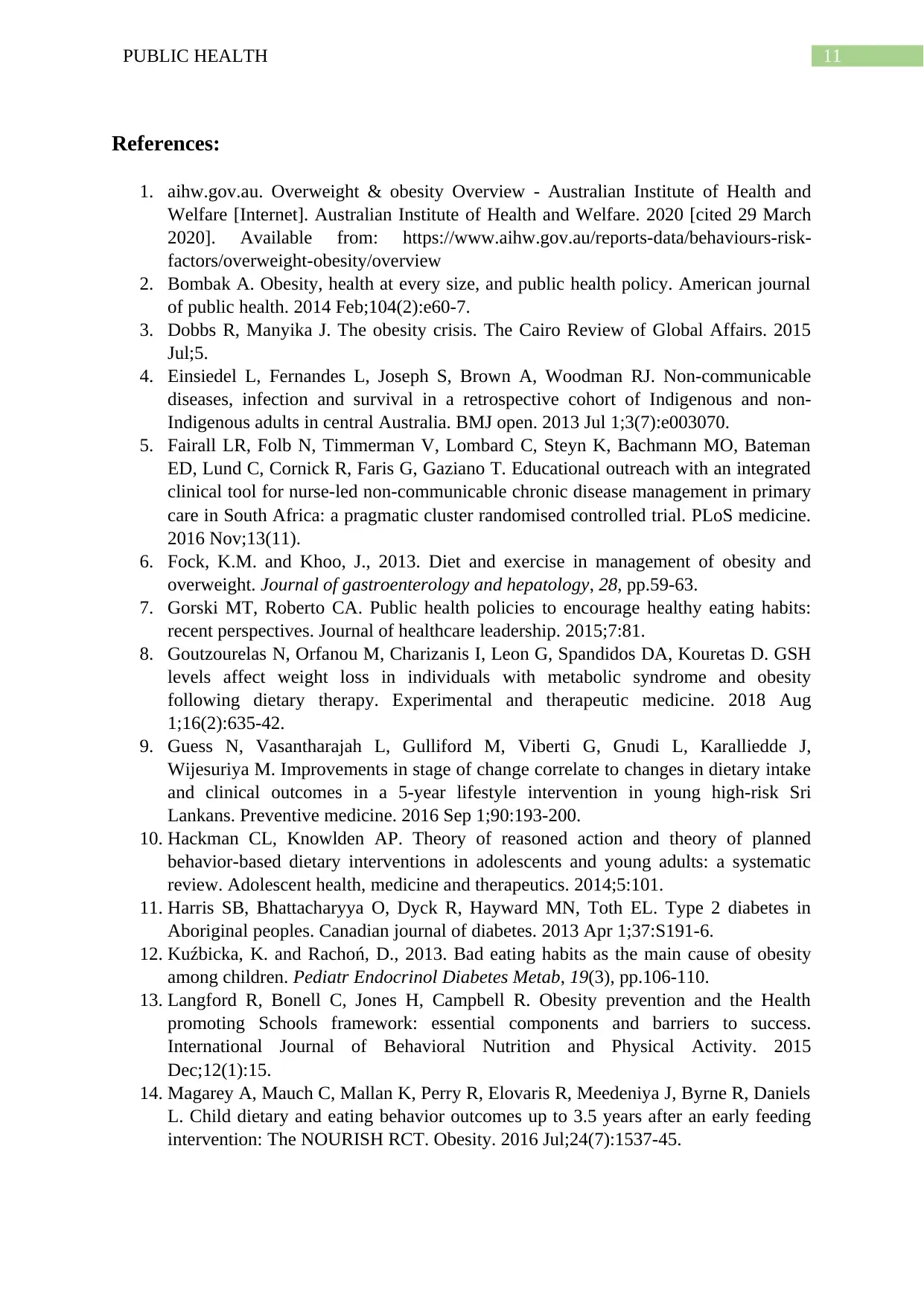
11PUBLIC HEALTH
References:
1. aihw.gov.au. Overweight & obesity Overview - Australian Institute of Health and
Welfare [Internet]. Australian Institute of Health and Welfare. 2020 [cited 29 March
2020]. Available from: https://www.aihw.gov.au/reports-data/behaviours-risk-
factors/overweight-obesity/overview
2. Bombak A. Obesity, health at every size, and public health policy. American journal
of public health. 2014 Feb;104(2):e60-7.
3. Dobbs R, Manyika J. The obesity crisis. The Cairo Review of Global Affairs. 2015
Jul;5.
4. Einsiedel L, Fernandes L, Joseph S, Brown A, Woodman RJ. Non-communicable
diseases, infection and survival in a retrospective cohort of Indigenous and non-
Indigenous adults in central Australia. BMJ open. 2013 Jul 1;3(7):e003070.
5. Fairall LR, Folb N, Timmerman V, Lombard C, Steyn K, Bachmann MO, Bateman
ED, Lund C, Cornick R, Faris G, Gaziano T. Educational outreach with an integrated
clinical tool for nurse-led non-communicable chronic disease management in primary
care in South Africa: a pragmatic cluster randomised controlled trial. PLoS medicine.
2016 Nov;13(11).
6. Fock, K.M. and Khoo, J., 2013. Diet and exercise in management of obesity and
overweight. Journal of gastroenterology and hepatology, 28, pp.59-63.
7. Gorski MT, Roberto CA. Public health policies to encourage healthy eating habits:
recent perspectives. Journal of healthcare leadership. 2015;7:81.
8. Goutzourelas N, Orfanou M, Charizanis I, Leon G, Spandidos DA, Kouretas D. GSH
levels affect weight loss in individuals with metabolic syndrome and obesity
following dietary therapy. Experimental and therapeutic medicine. 2018 Aug
1;16(2):635-42.
9. Guess N, Vasantharajah L, Gulliford M, Viberti G, Gnudi L, Karalliedde J,
Wijesuriya M. Improvements in stage of change correlate to changes in dietary intake
and clinical outcomes in a 5-year lifestyle intervention in young high-risk Sri
Lankans. Preventive medicine. 2016 Sep 1;90:193-200.
10. Hackman CL, Knowlden AP. Theory of reasoned action and theory of planned
behavior-based dietary interventions in adolescents and young adults: a systematic
review. Adolescent health, medicine and therapeutics. 2014;5:101.
11. Harris SB, Bhattacharyya O, Dyck R, Hayward MN, Toth EL. Type 2 diabetes in
Aboriginal peoples. Canadian journal of diabetes. 2013 Apr 1;37:S191-6.
12. Kuźbicka, K. and Rachoń, D., 2013. Bad eating habits as the main cause of obesity
among children. Pediatr Endocrinol Diabetes Metab, 19(3), pp.106-110.
13. Langford R, Bonell C, Jones H, Campbell R. Obesity prevention and the Health
promoting Schools framework: essential components and barriers to success.
International Journal of Behavioral Nutrition and Physical Activity. 2015
Dec;12(1):15.
14. Magarey A, Mauch C, Mallan K, Perry R, Elovaris R, Meedeniya J, Byrne R, Daniels
L. Child dietary and eating behavior outcomes up to 3.5 years after an early feeding
intervention: The NOURISH RCT. Obesity. 2016 Jul;24(7):1537-45.
References:
1. aihw.gov.au. Overweight & obesity Overview - Australian Institute of Health and
Welfare [Internet]. Australian Institute of Health and Welfare. 2020 [cited 29 March
2020]. Available from: https://www.aihw.gov.au/reports-data/behaviours-risk-
factors/overweight-obesity/overview
2. Bombak A. Obesity, health at every size, and public health policy. American journal
of public health. 2014 Feb;104(2):e60-7.
3. Dobbs R, Manyika J. The obesity crisis. The Cairo Review of Global Affairs. 2015
Jul;5.
4. Einsiedel L, Fernandes L, Joseph S, Brown A, Woodman RJ. Non-communicable
diseases, infection and survival in a retrospective cohort of Indigenous and non-
Indigenous adults in central Australia. BMJ open. 2013 Jul 1;3(7):e003070.
5. Fairall LR, Folb N, Timmerman V, Lombard C, Steyn K, Bachmann MO, Bateman
ED, Lund C, Cornick R, Faris G, Gaziano T. Educational outreach with an integrated
clinical tool for nurse-led non-communicable chronic disease management in primary
care in South Africa: a pragmatic cluster randomised controlled trial. PLoS medicine.
2016 Nov;13(11).
6. Fock, K.M. and Khoo, J., 2013. Diet and exercise in management of obesity and
overweight. Journal of gastroenterology and hepatology, 28, pp.59-63.
7. Gorski MT, Roberto CA. Public health policies to encourage healthy eating habits:
recent perspectives. Journal of healthcare leadership. 2015;7:81.
8. Goutzourelas N, Orfanou M, Charizanis I, Leon G, Spandidos DA, Kouretas D. GSH
levels affect weight loss in individuals with metabolic syndrome and obesity
following dietary therapy. Experimental and therapeutic medicine. 2018 Aug
1;16(2):635-42.
9. Guess N, Vasantharajah L, Gulliford M, Viberti G, Gnudi L, Karalliedde J,
Wijesuriya M. Improvements in stage of change correlate to changes in dietary intake
and clinical outcomes in a 5-year lifestyle intervention in young high-risk Sri
Lankans. Preventive medicine. 2016 Sep 1;90:193-200.
10. Hackman CL, Knowlden AP. Theory of reasoned action and theory of planned
behavior-based dietary interventions in adolescents and young adults: a systematic
review. Adolescent health, medicine and therapeutics. 2014;5:101.
11. Harris SB, Bhattacharyya O, Dyck R, Hayward MN, Toth EL. Type 2 diabetes in
Aboriginal peoples. Canadian journal of diabetes. 2013 Apr 1;37:S191-6.
12. Kuźbicka, K. and Rachoń, D., 2013. Bad eating habits as the main cause of obesity
among children. Pediatr Endocrinol Diabetes Metab, 19(3), pp.106-110.
13. Langford R, Bonell C, Jones H, Campbell R. Obesity prevention and the Health
promoting Schools framework: essential components and barriers to success.
International Journal of Behavioral Nutrition and Physical Activity. 2015
Dec;12(1):15.
14. Magarey A, Mauch C, Mallan K, Perry R, Elovaris R, Meedeniya J, Byrne R, Daniels
L. Child dietary and eating behavior outcomes up to 3.5 years after an early feeding
intervention: The NOURISH RCT. Obesity. 2016 Jul;24(7):1537-45.
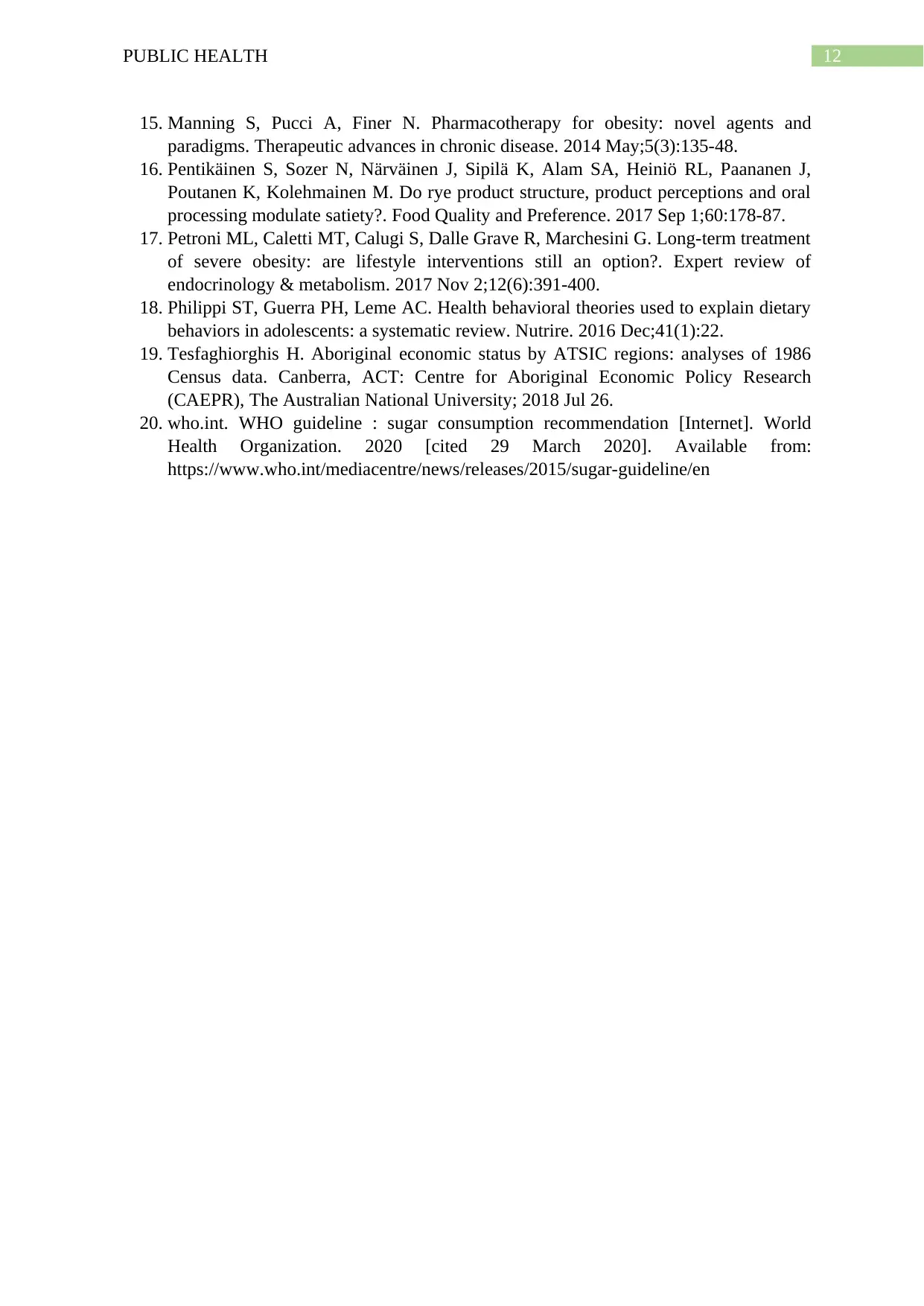
12PUBLIC HEALTH
15. Manning S, Pucci A, Finer N. Pharmacotherapy for obesity: novel agents and
paradigms. Therapeutic advances in chronic disease. 2014 May;5(3):135-48.
16. Pentikäinen S, Sozer N, Närväinen J, Sipilä K, Alam SA, Heiniö RL, Paananen J,
Poutanen K, Kolehmainen M. Do rye product structure, product perceptions and oral
processing modulate satiety?. Food Quality and Preference. 2017 Sep 1;60:178-87.
17. Petroni ML, Caletti MT, Calugi S, Dalle Grave R, Marchesini G. Long-term treatment
of severe obesity: are lifestyle interventions still an option?. Expert review of
endocrinology & metabolism. 2017 Nov 2;12(6):391-400.
18. Philippi ST, Guerra PH, Leme AC. Health behavioral theories used to explain dietary
behaviors in adolescents: a systematic review. Nutrire. 2016 Dec;41(1):22.
19. Tesfaghiorghis H. Aboriginal economic status by ATSIC regions: analyses of 1986
Census data. Canberra, ACT: Centre for Aboriginal Economic Policy Research
(CAEPR), The Australian National University; 2018 Jul 26.
20. who.int. WHO guideline : sugar consumption recommendation [Internet]. World
Health Organization. 2020 [cited 29 March 2020]. Available from:
https://www.who.int/mediacentre/news/releases/2015/sugar-guideline/en
15. Manning S, Pucci A, Finer N. Pharmacotherapy for obesity: novel agents and
paradigms. Therapeutic advances in chronic disease. 2014 May;5(3):135-48.
16. Pentikäinen S, Sozer N, Närväinen J, Sipilä K, Alam SA, Heiniö RL, Paananen J,
Poutanen K, Kolehmainen M. Do rye product structure, product perceptions and oral
processing modulate satiety?. Food Quality and Preference. 2017 Sep 1;60:178-87.
17. Petroni ML, Caletti MT, Calugi S, Dalle Grave R, Marchesini G. Long-term treatment
of severe obesity: are lifestyle interventions still an option?. Expert review of
endocrinology & metabolism. 2017 Nov 2;12(6):391-400.
18. Philippi ST, Guerra PH, Leme AC. Health behavioral theories used to explain dietary
behaviors in adolescents: a systematic review. Nutrire. 2016 Dec;41(1):22.
19. Tesfaghiorghis H. Aboriginal economic status by ATSIC regions: analyses of 1986
Census data. Canberra, ACT: Centre for Aboriginal Economic Policy Research
(CAEPR), The Australian National University; 2018 Jul 26.
20. who.int. WHO guideline : sugar consumption recommendation [Internet]. World
Health Organization. 2020 [cited 29 March 2020]. Available from:
https://www.who.int/mediacentre/news/releases/2015/sugar-guideline/en
1 out of 13
Related Documents
Your All-in-One AI-Powered Toolkit for Academic Success.
+13062052269
info@desklib.com
Available 24*7 on WhatsApp / Email
![[object Object]](/_next/static/media/star-bottom.7253800d.svg)
Unlock your academic potential
© 2024 | Zucol Services PVT LTD | All rights reserved.





